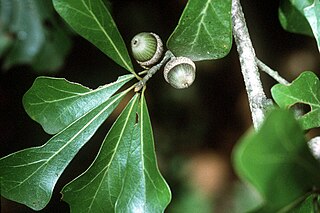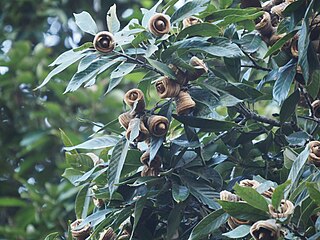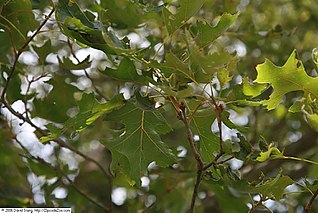
Quercus marilandica, the blackjack oak, is a small oak, one of the red oak group Quercus sect. Lobatae. It is native to the eastern and central United States.

Quercus laevis, the turkey oak, is a member of the red oak group of oaks. It is native to the southeastern United States. The name turkey oak derives from the resemblance of the leaves to a turkey's foot. A Turkish and southern European species Quercus cerris is also commonly referred to as Turkey oak, so Quercus laevis is sometimes referred to as American turkey oak to distinguish it from the European species.

Quercus dentata, also called Japanese emperor oak or daimyo oak is a species of oak native to East Asia. The name of the tree is often translated as "sweet oak" in English to distinguish it from Western varieties. It is placed in section Quercus.

Quercus nigra, the water oak, is an oak in the red oak group, native to the eastern and south-central United States, found in all the coastal states from New Jersey to Texas, and inland as far as Oklahoma, Kentucky, and southern Missouri. It occurs in lowlands and up to 450 meters in elevation.

Quercus arkansana, the Arkansas oak, is a species of oak tree. It is native to the southeastern United States. It is threatened by use of its habitat for pine plantations, clearing of land, and diebacks that may be caused by drought.
Shorea obtusa, the Siamese sal, is a species of hardwood tree in the family Dipterocarpaceae, native to Southeast Asia.

Quercus alnifolia, commonly known as the golden oak, is an evergreen oak species of Cyprus. Its common English name refers to the golden coloured lower surface of its leaves. Quercus alnifolia belongs to the endemic flora of the island and it is confined to the igneous geological complex of the Troodos Mountains. In February 2006, the parliament of Cyprus selected the golden oak to be the country's national tree.
Quercus asymmetrica is an oak tree species in the beech family Fagaceae. It is found in China and northern Vietnam. It is placed in subgenus Cerris, section Cyclobalanopsis.
Quercus petelotii is the accepted name of an endemic oak tree species in the beech family Fagaceae; there are no known sub-species. It is placed in subgenus Cerris, section Cyclobalanopsis.
Quercus arbutifolia, synonym Quercus obovatifolia, is a species of oak in the beech family Fagaceae, native to southeast China and Vietnam. It is placed in Quercus sect. Cyclobalanopsis, the ring-cupped oaks. There are no known subspecies.
Quercus braianensis is a tree species in the beech family Fagaceae. There are no known subspecies. It is placed in subgenus Cerris, section Cyclobalanopsis.
Quercus rupestris is a small tree species in the beech family Fagaceae. It is placed in subgenus Cerris, section Cyclobalanopsis.
Quercus subsericea is a tree species in the beech family Fagaceae. There are no known subspecies. It is placed in subgenus Cerris, section Cyclobalanopsis.
Quercus setulosa is the accepted name of an oak species in genus Quercus of the family Fagaceae. It is now placed in section Ilex of subgenus Cerris.
Quercus quangtriensis is a tree species in the beech family Fagaceae; there are no known subspecies. It is placed in subgenus Cerris, section Cyclobalanopsis.

Quercus macrocalyx is a tree species in the beech family Fagaceae There are no known subspecies. It is placed in subgenus Cerris, section Cyclobalanopsis.

Quercus gomeziana is a tree species in the beech family Fagaceae. There are no known subspecies. It is placed in subgenus Cerris, section Cyclobalanopsis.

Pterocymbium tinctorium is a tropical forest tree species in the family Malvaceae, subfamily Sterculioideae. In Vietnam, it is known as dực nang nhuộm. In Indonesia, it is called kelumbuk, where it is a significant timber tree growing to about 25 m high. In the Philippines it is called malasapsap.
Pinanga sylvestris is a species of tree in the Arecaceae, or palm tree, family. It grows 2-6 m tall, sometimes in bundles, shade tolerant, from Meghalaya (India) to Thailand, Cambodia, Vietnam, Laos and Zhōngguó/China. In Thailand it is recorded in the Khao Soi Dao Wildlife Sanctuary, in Chanthaburi Province, as a very common mid-storey tree in the Quercus semiserrata-dominated rainforest at 1,400 to 1,540 m. In Cambodia it occurs uncommonly in coastal vegetation communities, but is common in dense and semi-dense evergreen rainforest in the lowlands and at moderate altitude. The palm grows in similar dense and semi-dense communities in Laos and Vietnam. On the mountain of Ngọc Linh in Quảng Nam Province of Vietnam, it dominates the ground layer of low montane broadleaf evergreen forest, that occurs from 150 to 1000m.
Quercus lowii is a species of oak (Quercus) native to the mountains of northern Borneo.









